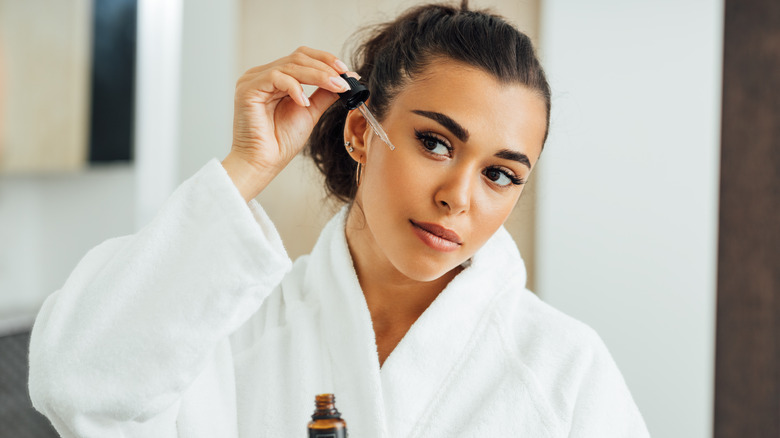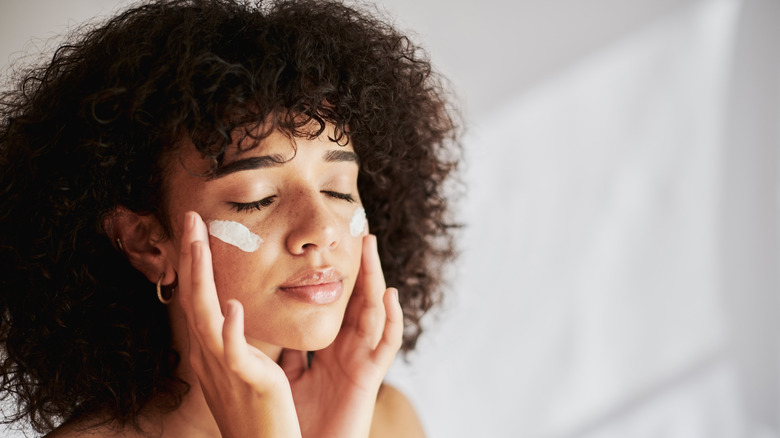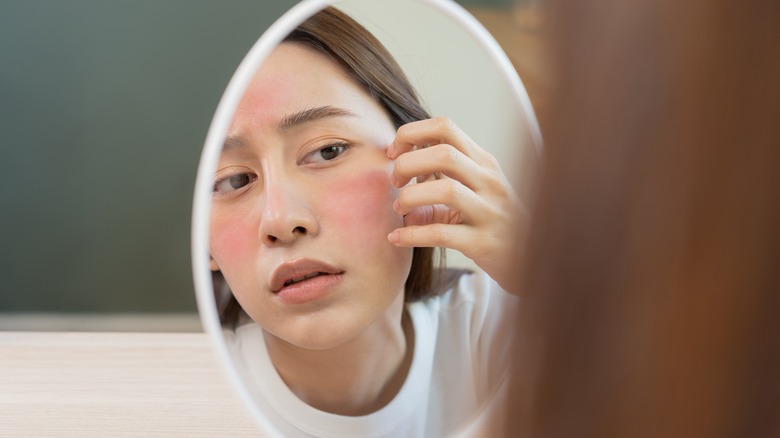Your Guide To Adding Azelaic Acid Into Your Skincare Routine
It seems like almost every day we hear about a new miracle ingredient in the skincare world that promises to give us filter-effect flawless skin. The latest name you need to know? Azelaic acid. Azelaic acid is a natural acid taken from grains that can also appear naturally on the skin. It's finally making some noise in the beauty world, thanks to its ability to improve the skin in a number of different ways.
The product has been proven to help even out the skin tone and aid hyperpigmentation issues, as well as minimize red scars and dark spots. It can also be used by people with acne or those with rosacea. Because azelaic acid is an antibacterial antioxidant, it's actually been known to help unclog pores, which, in turn, helps with blemishes and fights inflammation. All that and it's also milder than a lot of other acids. That makes it ideal for people with sensitive skin, as it's less likely to cause a reaction.
Though it's actually been around for a while now, azelaic acid has gone somewhat unnoticed. So much so that board-certified dermatologist Dr. Azadeh Shirazi even described it as "one of the most underrated skin-care ingredients" to Allure. But no more! It may finally be time for you to give azelaic acid a go — and this is what you need to know before incorporating it into your skincare routine.
Know you may need a prescription
If you're looking for a high concentration of azelaic acid, you should be prepared to get a prescription. Products with up to 10% of the ingredient can be bought over the counter, but for anything up to the maximum of 20% strength, you'll need to go through your doctor or dermatologist first.
Don't think going for a lower concentration means you won't get all the benefits, as that's not exactly true. Board-certified dermatologist Dr. Michelle Green confirmed that to Allure, stating that "Skin-care products with a low concentration of azelaic acid can be beneficial when it comes to unclogging pores, preventing acne breakouts, and soothing skin inflammation," she said.
Equally, lower-concentration products can actually be very useful when used alongside other skincare products. As board-certified cosmetic dermatologist, Dr. Rachel Westbay explained to NBC Select, combining a lower concentration of the acid with other products designed to combat acne can actually potentially work better than a solo higher concentration product. "[A combination can be] much more effective than when [azelaic acid is] used alone," they shared.
Make sure you're taking precautions
Just like when applying any new products, there are precautions to take. We'd recommend only adding azelaic acid to your routine, not multiple new products at one time. That's because if it turns out azelaic acid isn't right for your skin, you'll actually be able to identify which product isn't for you — as well as minimize the risk of irritation.
Equally, you'll want to make sure you're going extra hard when it comes to applying sunscreen religiously. And we don't just mean on those sunny days. SPF products should be part of your skincare routine every single day after all, especially when you're applying skincare acids. "If you are using azelaic acid, you definitely should be religious about applying sunscreen — even low levels of UV light can promote pigmentation and undo what you have treated," Dr. Joshua Zeichner, director of cosmetic and clinical research at Mount Sinai Hospital, told NBC Select.
You'll also want to do your research on what products that are already part of your skincare you can pair with the new addition. Because some skincare ingredients just don't mix. "I wouldn't put [azelaic acid] on top of other products with salicylic acid or glycolic acid because you're going to compound that irritation. Typically, you want to either remove other irritating things from the regimen or at least separate them, so you can use one thing in the morning and another at nighttime," board-certified dermatologist Dr. Ronda Farah explained.
Know some people should avoid azelaic acid
While azelaic acid generally tends to be safe for everyone to use, you'll still want to be careful of the product if you have very sensitive skin. Dr. Ronda Farah explained to NBC Select that although the product tends to be on the milder side (particularly when used in smaller concentrations) there can still be side effects. Like any acid product being applied to the skin, there's still a chance of it causing a burning sensation, irritation, or resulting in redness. It could even cause hyperpigmentation patches in extreme cases. "If you get a rash going, it can leave dark spots instead of what you actually intended it to do, which is to lighten and brighten the skin," shared Dr. Farah. Azelaic acid can also cause dryness, or peeling around the application area. Anyone experiencing these symptoms should stop using the ingredient immediately.
Equally, because azelaic acid is a bit milder, for those with extreme cystic acne, something stronger may be required which may make investing in this product a waste of money. Dr. Lindsey Bordone, a board-certified dermatologist and assistant professor of dermatology at Columbia University Medical Center, explained that's because the acid doesn't penetrate the skin deep enough to fight more severe blemishes or acne issues.
And remember azelaic acid can require a lot of patience
Adding azelaic acid to your skincare routine? Then you'll probably want to add a dose of patience too. That's because the acid is so mild, it can take quite a while for you to actually see any benefits. Dr. Ronda Farah explained to NBC News that it could take anywhere from half a year to a full year to start seeing the results on your skin. That is if you're lucky enough to see any results at all. "It's one of the weaker acids, which is nice because of fewer side effects or dryness, but it's also not as helpful at clearing up the skin as stronger acne-fighting ingredients," Dr. Aaron Secrest, board-certified dermatologist and assistant professor of dermatology at the University of Utah, admitted.
However, if you apply azelaic acid as intended, you're much more likely to see those intended results eventually. But what is the best way to use it? Experts recommend applying the product after cleansing in the morning and/or evening (depending on any recommendations from your dermatologist). It should also be applied as its own layer (either all over the skin or only on the affected areas) before any other skincare products. Always remember that layers of skincare, especially when it comes to sunscreen, are always better than direct mixing.




